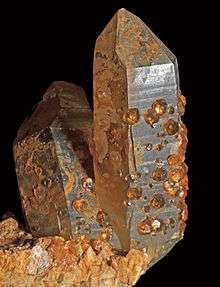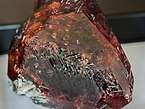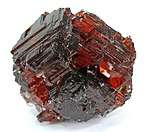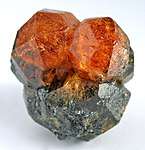Spessartine
Spessartine, sometimes mistakenly referred to as spessartite,[5] is a nesosilicate, manganese aluminium garnet species, Mn2+3Al2(SiO4)3.[1][2][3][4] The mineral spessartine should not be confused with a type of igneous rock (a lamprophyre) called spessartite.
| Spessartine | |
|---|---|
 Spessartine crystals on larger quartz crystals from China | |
| General | |
| Category | Nesosilicate Garnet group |
| Formula (repeating unit) | Mn2+3Al2(SiO4)3 |
| Strunz classification | 9.AD.25 |
| Crystal system | Isometric |
| Crystal class | Hexoctahedral (m3m) H-M symbol: (4/m 3 2/m) |
| Space group | Ia3d |
| Unit cell | a = 11.63 Å; Z = 8 |
| Identification | |
| Color | Yellow through red |
| Crystal habit | Massive to crystalline |
| Cleavage | None |
| Fracture | Sub-conchoidal |
| Tenacity | Brittle |
| Mohs scale hardness | 6.5 – 7.5 |
| Luster | Vitreous |
| Streak | White |
| Diaphaneity | Transparent to translucent |
| Specific gravity | 4.19 calculated, 4.12 – 4.32 measured |
| Optical properties | Isotropic, often anomalous double refractive |
| Refractive index | 1.800 |
| Birefringence | none |
| Dispersion | Weak |
| Absorption spectra | Bands at 410, 420, 430 nm (or merging to form cutoff below 430 nm; also bands at 460, 480, 520 nm. Possible weak bands at 504 or 573 nm[1] |
| References | [2][3][4] |
Spessartine's name is a derivative of Spessart in Bavaria, Germany, the type locality of the mineral.[2][3] It occurs most often in granite pegmatite[2][3][4] and allied rock types and in certain low-grade metamorphic phyllites. Sources include Australia, Myanmar, India, Afghanistan, Israel, Madagascar, Namibia, Nigeria, Mozambique, Tanzania and the United States.[1] Spessartine of an orange-yellow has been called Mandarin garnet and is found in Madagascar. Violet-red spessartines are found in rhyolites in Colorado and Maine. In Madagascar, spessartines are exploited either in their bedrock or in alluvium. The orange garnets result from sodium-rich pegmatites. Spessartines are found in bedrock in the highlands in the Sahatany valley. Those in alluvium are generally found in southern Madagascar or in the Maevatanana region.[6][7][8][9][10]
Spessartine forms a solid solution series with the garnet species almandine.[3][4] Well-formed crystals from this series, varying in color from very dark-red to bright yellow-orange, were found in Latinka, Rhodope Mountains, Kardzhali Province, Bulgaria.[11] Spessartine, like the other garnets, always occurs as a blend with other species. Gems with high spessartine content tend toward a light orange hue, while almandine prevalence induces red or brownish hues.[12]
Images
References
- Gemological Institute of America, GIA Gem Reference Guide 1995, ISBN 0-87311-019-6
- Webmineral Spessartine page
- Mindat Spessartine page
- Handbook of Mineralogy Spessartine page
- International Mineralogical Association (1971). "International Mineralogical Association: Commission on new minerals and mineral names" (PDF). Mineralogical Magazine. 38 (293): 102–105. doi:10.1180/minmag.1971.038.293.14.
- "Gem News". Gems & Gemology. 34 (1): 50–63. 1998-04-01. doi:10.5741/GEMS.34.1.50.
- Shigley, James; Dona Dirlam; Brendan Laurs; Edward Boehm; George Bosshart; William Larson (2000). "Gem localities of the 1990s". Gems & Gemology. 36 (4): 292–335. doi:10.5741/GEMS.36.4.292.
- Laurs, Brendan; Kimberly Knox (2001). "Spessartine garnet from Ramona, San Diego County, California". Gems & Gemology. 37 (4): 278–295. doi:10.5741/GEMS.37.4.278.
- Rossman, George R. (2009). "The geochemistry of gems and its relevance to gemology: different traces, different prices". Elements. 5 (3): 159–162. doi:10.2113/gselements.5.3.159. ISSN 1811-5209.
- Schmetzer, Karl; Thomas Hainschwang; Lore Kiefert; Heinz-Jürgen Bernhardt (2001). "Pink to pinkish orange Malaya garnets from Bekily, Madagascar". Gems & Gemology. 37 (4): 296–308. doi:10.5741/GEMS.37.4.296.
- "Spessartine from Latinka, Bulgaria".
- Spessartite Garnet Gemological Information
External links
![]()

.jpg)

